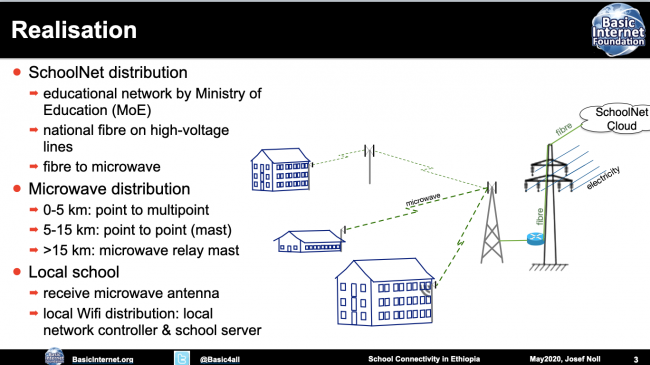Internet over High-Voltage Power Lines
| Wiki for ITS | ||||||
|---|---|---|---|---|---|---|
|
Internet over High-Power Voltage lines
The concept of distributing Internet over high-voltage lines to remote areas is based on a fibre cable being enclosed in the cable on top of a high-voltage power mast. Electricity is best carried over long distances at high voltages, and then the voltage is reduced in steps as the power is brought closer to houses and businesses. In the UK, as in most other countries, the National Grid operates at 400,000V with conductors carried on massive steel pylons from power stations to primary substations where it is converted to 132,000V for regional distribution[1]. In Europe, electricity companies own that fibre, located on top of the masts, and use it for communication regarding the electricity network. The cable is a combined structure including the optical fibre and used for communication and operation of electricity networks, mainly between the major sub-stations and control centres.
Note: this page is more about the principles, and the reader is asked to get more information from the references. Regarding technologies being used for fibre-optical cables on overhead power lines, the three technologies ADSS, OPPC and AccessWrap are dominant. Please refer to Jim Rowe's article for technology details[1]. Regarding the structure of the cable, I suggest to use the Wikipedia article on Optical ground wire[2]. Regarding the principle of power lines, please refer to Overhead power line on Wikipedia[3]
In Ethiopia, the government has connected the fibre to the national SchoolNet, and envisaged school connectivity in using the fibre. The idea is to
- take the fibre down in regional villages
- add a fibre to radio gateway
- distribute the Internet over radio through dedicated or shared radio links reaching out to the schools
As Jim Rowe argues, the three driving forces are speed, security and costs[1]:
- Speed: The installation is very fast, as you often have existing poles.
- Security: by adding fibre-optics on top of the masts the fibre-optics are away from ground activities, and are not hampered by e.g. flooding
- Costs: Re-using infrastructure has always a big cost advantage. Though, it needs regulatory agreements.
The same technologies that have been used since the 1980s to add fibre-optic cables to large transmission lines is also applicable to distribution lines, though the structures of the poles might need to be adjusted.
References
- ↑ 1.0 1.1 1.2 Jim Rowe, "Using overhead distribution lines to carry fibre optic cables", online, assessed 4Aug2020, http://www.beyondbroadband.coop/kb/using-overhead-distribution-lines-carry-fibre-optic-cables
- ↑ Optical ground wire, Online, assessed 4Aug2020, https://en.wikipedia.org/wiki/Optical_ground_wire
- ↑ Overhead power line, online, assessed 4Aug2020, https://en.wikipedia.org/wiki/Overhead_power_line
